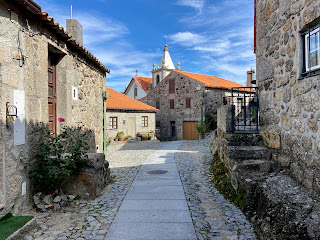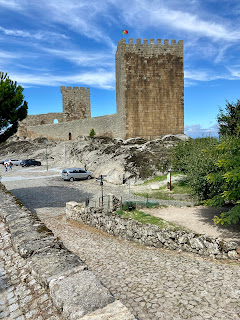A longer drive west brings us to Linhares (da Beira, pop 213 in 2021), a small village with an oversized fortress. There are a few other tourists, but all the cafes and shops are closed. Despite the lack of inhabitants, the streets are sparkling.
The Castelo de Linhares da Beira (twelfth century) stretches along a ridge facing a broad vacant plaza to the south. Behind us is the Igreja Matriz (de Nossa Senhora da Assunção, seventeenth century), which stands above a sloping square with more empty restaurants.
The entrance to the Castelo is a groove worn into the tremendous limestone boulder at the base of the castle walls, and a thin railing marks the way.
Saramago's traveller provides this description:
The castle must have been enormous. This is obvious from the two huge granite corner towers, the height of the walls, and the whole fortress-like atmosphere that still exists inside. It needed to be huge, because in the days of the wars against the Saracens, this was a forward post for the Portuguese. That was in the reign of Dom Dinis, of whom the traveller will have occasion to speak again soon. Who knows whether it was not in this castle that inspiration came to the poet-king, as he looked out on the pinewoods below: “Oh flowers, oh the flowers of green pine.” Well, the traveller himself is inspired today, but he must not overstay his welcome, because this visit is in the mason’s lunch-hour, so it is time for him to say goodbye and leave Linhares, which from afar looked so like Mycenae and took him so long to reach it could well have been the Greek city. (José Saramago, “Journey to Portugal,” 1990; trans Hopkinson-Caistor, 2000)
There are two similarly scaled rectangular towers. One stands at the far eastern end of the complex, the other in the middle. Between the two towers is an irregular, narrow yard, or bailey, and to the west of the central tower is a much larger, wider bailey.
Inside the smaller bailey, there is a walkway made of overlapping concrete squares. The walkway connects the eastern tower to a gate in through the wall with the high parapet, next to the central tower. Though there are stairs leading up to the tower doors, both are locked.
The larger bailey pitches down to the west and provides some amazing views to the Vale do Montego. The thin railings continue along the parapet and are much appreciated – some care being shown for the safety of visitors.
As we leave, among the half-buried rocks, we notice a small figure staring skyward. It looks like a gargoyle, but there is no gutter; or perhaps it is a support for a timber beam long gone.
We take a closer look at the Igreja Matriz. The dedication stone says 1743, but parts of the church look much older. The doorways on the north side suggest a Romanesque origin, with some decorative carvings still intact. Closer to the entrance, another doorway appears to be filled-in, and may have led to a baptistry or chapel in earlier times.
Along the south side a series of stone brackets suggest a connection to our enigmatic friend from the Castelo.
Just to the north of the Igreja is the Fonte de São Caetano (nineteenth century), and just down the hill, the cemitério. A quick walk down the Rua da Igreja brings us to the pelourinho, where we finally meet a few locals having coffee.
Just around the corner is the Igreja da Misericórdia (de Santo Isidora, thirteenth and sixteenth centuries). There is a bit more activity at this end of town; a local lady is hanging her laundry near her garden. There are neck-craning views back to the Castelo. We find the forum stand that the traveller mentions:
And here, in the middle of the street, is a stone platform or forum that used to have a roof but now does not. This was where the town council met: they sat on these benches and discussed the town’s affairs out loud, in sight of the townspeople, who could hear everything through the open windows. Those were simple times, but this practice convinces the traveller they were good ones too: in those days there were no massive doors or velvet seats, and perhaps when it rained the session was interrupted so that public and passers-by could shelter under the canopy. (José Saramago, “Journey to Portugal,” 1990; trans Hopkinson-Caistor, 2000)
We drive off to Trancoso (pop 9,878 in 2011) for lunch. We park near the Casa do Gato Preto, with its Leão de Judá, and immediately head down the Rua da Corredoura to the Portas d'El Rei, Trancoso's emblematic structure. The Ports are flanked by two stubby, crenellated towers, with a lower central gap, with a single, pointy merlon.
On one side of the Portas contains the medieval town, the other side opens to a sizable, triangular plaza paved and delimited with granite blocks and modern buildings.
After lunch, we return to the Praça Dom Dinis. At the eastern end of the Praça is the pelourinho and the Igreja de São Pedro (eighteenth century), and across the street is the Igreja da Misericórdia (with quatrefoil window, eighteenth century). Just to the north of the Praça are the substantial ruins of the Palácio Ducal (eighteenth century), with its gracious upswept pediment and royal crest – this is currently being renovated into some kind of museum.
From here, we plunge into the alleyways all lined with potted plants.
A short climb brings us to the Castelo de Trancoso (twelfth and thirteenth centuries). An integrated modern stair provides access as well as a chronology – a timeline that covers a thousand and fifty years, from 960 to 2010.
The walls enclose an oblong yard with a series of rectangular bastion towers. We see three recent interventions built in dark wood. A long reception office, like a mobile home, is near the gate. A deck in front of a Romanesque arch covers the foundations of the Capela da Santa Bárbara. Finally, two vertical wooden slices sandwich a steel stair in front of the trapezoidal Torre de Menagem. These three interventions, but particularly the stair, are distracting; we hope they are are temporary or necessary safety features.
On our way back to the car, we see that the door to the Igreja de São Pedro is open, as step in. The space is quite plain except for the Baroque altar and side chapels. The ceiling of the vault is painted with the triregnum and keys in honor of São Pedro. In the left-hand side chapel, the Virgin's halo reads: Eu sou a Immaculada Conceição.
We arrive in Marialva in the late afternoon and are afraid it may have closed. Theo door to the bilheteria is locked. We peer into the Capela de Nossa Senhora de Lourdes (seventeenth century). Our iPhones are able to pierce the glass reflections and capture the interior through the window screens. The arch for the Virgin's stand holds a familiar text: Eu sou a Immaculada Conceição. However, the figure on Her right-hand side appears to be a Sith Lord.
Almost as a joke, we knock on the castle door, and unbelievably, a docent strolls from behind with another tourist, pulls the chain from the gate and opens it. She tells us the bilheteria is open at the lower level, and we may buy tickets there.
To our amazement, the Castelo de Marialva (twelfth century) is a warren of broken structures, punctuated by towers, strewn over an uneven landscape. It is glorious. It is a real departure from the wide, empty yards of Trancoso and Linhares. From our research, the satellite views do not prepare us for the ruined, romantic nature of the compound. We recognize the traveller's reaction:
There are ruined dwellings, the keep, the courtyard, the dungeon, other places no longer identifiable, and it is this complex of ruined buildings, and the mystery that unites them, the present memory of all those who lived here, that suddenly moves the traveller, brings a lump to his throat and tears to his eyes. Do not conclude from this that he is a romantic, but rather that he is a very lucky man: lucky to have been here on this day, at this moment, to have come in alone and to have been left alone, and to have had the sensitivity to grasp and hold the presence of the past, of history, of the men and women who lived, loved, worked, suffered and died in this castle. In the castle of Marialva, the traveller felt a great responsibility. For a minute, and so intensely it became unbearable, he saw himself as the meeting point of past and future. May whoever is reading these lines feel the same thing, and then tell me how it felt. (José Saramago, “Journey to Portugal,” 1990; trans Hopkinson-Caistor, 2000)
Entering from the west, we make a circuit 'to the left', as instructed by the docent. We pass a bell tower, and climb toward the northern bastion tower, which appears to be the high point. The tower is missing a jagged corner, and the parapet does not pass through it. We scramble down and back up the other side to continue our survey.
The traveller spent almost all the rest of the afternoon roaming among its stones and streets. Old Alfredo Brígida appeared to point out, as if they were secrets, the gunpowder store, the engraved stone at the castle entrance, the ship’s prow formed by one of the towers. Then he took him to the village to show him other ancient things, people’s faces, the church of Santiago, the tombs cut directly into the rock as in Moreira de Rei. The sun is setting. The castle is glowing with light on one side, is submerged in cindery darkness on the other. The traveller is on his own again, he climbs the streets once more, and by now is an old acquaintance of the inhabitants: “Hello; back again, are you?” He goes into the castle again, into its darkest corners, as if hoping to hear some kind of revelation, some final explanation. (José Saramago, “Journey to Portugal,” 1990; trans Hopkinson-Caistor, 2000)
On a level just below and to the south of the Torre de Menagem. The larger Igreja de São Tiago (sixteenth century) facing west, and the Capela do Senhor dos Passos (seventeenth century) facing east. There is a cemitério full of well-tended markers, the flowers providing an unexpected splash of color among the grey blocks.
From there, we enter the remains of the village. There is the pelourinho, next to the Antiga Câmara Municipal (seventeenth century) and the Antiga Cadeia (jail).
We enter the portal to the walls of the keep, and climb to the upper parapet, with marvelous views over the entire aldeia histórica
He is out on the plain again, with the sun shining level with his eyes. Something has grown inside him since his visit to Marialva Castle. Or perhaps the castle is going with him, and makes him seem bigger than before. Anything can happen on journeys like this. (José Saramago, “Journey to Portugal,” 1990; trans Hopkinson-Caistor, 2000)
Back in Alfaiates, we get another stunning sunset, complete with crescent moon.





















































































































































No comments:
Post a Comment